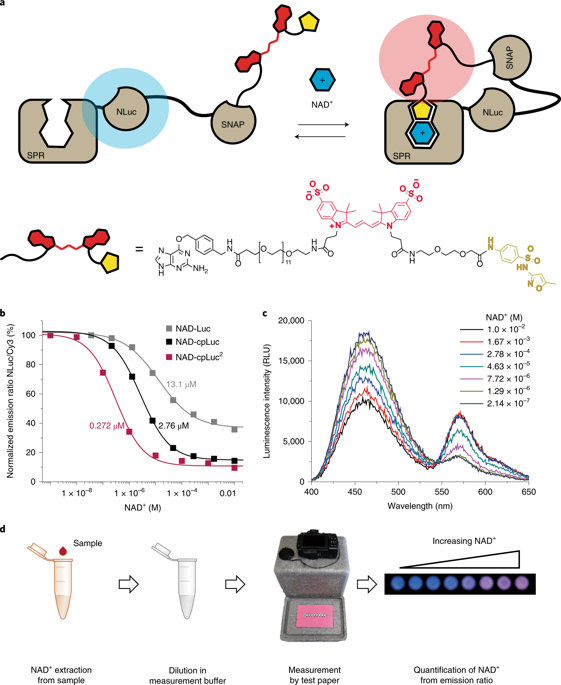Nature Metabolism ( IF 18.9 ) Pub Date : 2019-12-13 , DOI: 10.1038/s42255-019-0151-7 Qiuliyang Yu 1, 2 , Narges Pourmandi 1 , Lin Xue 1 , Corentin Gondrand 1 , Sebastian Fabritz 1 , Daniel Bardy 3 , Luc Patiny 2 , Elena Katsyuba 4, 5 , Johan Auwerx 4 , Kai Johnsson 1, 2

|
The cellular level of nicotinamide adenine dinucleotide (NAD+), through its different functions, affects cellular metabolism and signalling1,2,3. A decrease in the NAD+ content has been associated with various pathologies and physiological aging4,5, while strategies to boost cellular NAD+ levels have been shown to be effective against age-related diseases in many animal models6. The link between decreased NAD+ levels and numerous pathologies and physiological aging has triggered the need for a simple quantification method for NAD+, ideally applicable at the point of care. Here, we introduce a bioluminescent biosensor for the rapid quantification of NAD+ levels in biological samples, which can be used either in laboratories or at the point of care. The biosensor is a semisynthetic, light-emitting sensor protein that changes the colour of emitted light from blue to red on binding of NAD+. This NAD+-dependent colour change enables the use of the biosensor in paper-based assays in which NAD+ is quantified by measuring the colour of the emitted light by using either a simple digital camera or a plate reader. We used the approach to quantify NAD+ levels in cell culture, tissue and blood samples, yielding results that agreed with those from standard testing methods. The same biosensor furthermore allows the quantification of NAD+-dependent enzymatic activities in blood samples, thus expanding its utility as a tool for point-of-care diagnostics.
中文翻译:

用于在护理点测量NAD +水平的生物传感器。
细胞水平的烟酰胺腺嘌呤二核苷酸(NAD +),通过其不同的功能,影响细胞的代谢和1,2,3信号。NAD +含量的下降与各种病理学和生理衰老[ 4,5]有关,而在许多动物模型中,提高细胞NAD +水平的策略已被证明可有效对抗与年龄有关的疾病6。降低的NAD +水平与多种病理和生理衰老之间的联系引发了对NAD +的简单定量方法的需求,最适合在护理时使用。在这里,我们介绍一种生物发光生物传感器,用于快速定量生物样品中NAD +的水平,可在实验室或护理现场使用。生物传感器是一种半合成的发光传感器蛋白,在结合NAD +时将发射光的颜色从蓝色变为红色。这种NAD +依赖性的颜色变化使该生物传感器可用于基于纸张的测定,在该测定中,通过使用简单的数码相机或酶标仪测量发射光的颜色来定量NAD +。我们使用这种方法来量化NAD +细胞培养物,组织和血液样品中的水平,其结果与标准测试方法的结果一致。相同的生物传感器还允许量化血样中NAD +依赖性酶的活性,从而扩展了其作为即时诊断的工具的效用。











































 京公网安备 11010802027423号
京公网安备 11010802027423号